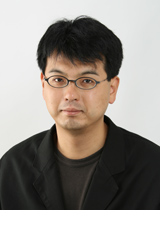Motoi Miura Director
 Born in 1973. Graduated Toho Gakuen College of Drama and Music Department of Theater, Toho Gakuen Major Course. As a student he studied under acclaimed directors such as Kouichi Kimura, Yukio Ninagawa, and Mitsumasa Shinozaki. In 1996 Miura joined the theater company, Seinendan, and became the assistant director to Oriza Hirata, and full time staff to the Komaba Agora Theater. From 1999 he studied and worked in Paris for two years on a research grant from Japan's Agency for Cultural Affair. He was trained not only in directing, but also in art management and art directions at Théâtre Gerard Philipe, Centre Dramatique National de Saint-Denis, and Le Quartz-Scène nationale de Brest under art the director Jacques Blanc. As he returned to Japan in 2001 he became active as the representative for Chiten. He worked with radical plays from all around the world and also became a pioneer in Japan for many foreign scripts, such as ones written by Jon Fosse (Norway), and David Harrower (Scottland). In 2005 Chiten became independent of Seinendan and moved to Kyoto. In September of the same year he was awarded at the Toga Director Competition, and in 2006 he won Best Scenography at The Cairo International Festival for Experimental Theatre. From 2007 he began to produce The Four Masterpieces of Chekov and won the Agency of Cultural Affairs New Director Award for the "Cherry Orchard". In March 2008 he was highly recognized for his first opera "In the Penal Colony" (Words by Franz Kafka; Composed by Philip Glass, Sponsered by Tokyo Chamber Opera Theatre). In 2008 he was award the Kyoto City Special Bounty Program for Art and Culture.
Born in 1973. Graduated Toho Gakuen College of Drama and Music Department of Theater, Toho Gakuen Major Course. As a student he studied under acclaimed directors such as Kouichi Kimura, Yukio Ninagawa, and Mitsumasa Shinozaki. In 1996 Miura joined the theater company, Seinendan, and became the assistant director to Oriza Hirata, and full time staff to the Komaba Agora Theater. From 1999 he studied and worked in Paris for two years on a research grant from Japan's Agency for Cultural Affair. He was trained not only in directing, but also in art management and art directions at Théâtre Gerard Philipe, Centre Dramatique National de Saint-Denis, and Le Quartz-Scène nationale de Brest under art the director Jacques Blanc. As he returned to Japan in 2001 he became active as the representative for Chiten. He worked with radical plays from all around the world and also became a pioneer in Japan for many foreign scripts, such as ones written by Jon Fosse (Norway), and David Harrower (Scottland). In 2005 Chiten became independent of Seinendan and moved to Kyoto. In September of the same year he was awarded at the Toga Director Competition, and in 2006 he won Best Scenography at The Cairo International Festival for Experimental Theatre. From 2007 he began to produce The Four Masterpieces of Chekov and won the Agency of Cultural Affairs New Director Award for the "Cherry Orchard". In March 2008 he was highly recognized for his first opera "In the Penal Colony" (Words by Franz Kafka; Composed by Philip Glass, Sponsered by Tokyo Chamber Opera Theatre). In 2008 he was award the Kyoto City Special Bounty Program for Art and Culture.
Chiten
Founded in 1997 as Seinendan Link company Chiten. Became independent on April 2005 and moved their base to Kyoto. While the role of a playwright and director is often combined in Japan, Chiten is unique by having the director stay devoted to directing. The company adopts various texts to produce expressive theater where words, light, sound, texture, and the human body converges on stage. They are recognized as "Avant-garde and innovative," for their style of reconstruction of meaning by careful interpretations of the text.




